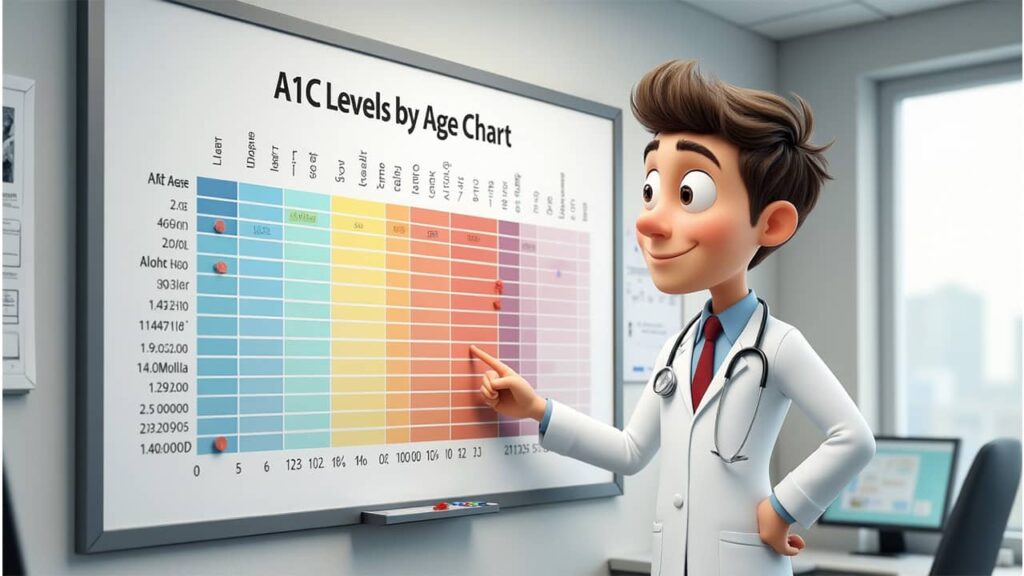A1C Levels by Age Chart?: Essential Guide for Every Age

A1C Levels by Age Chart? is the ultimate tool to understand your average blood sugar levels over time, helping you track your health and make informed lifestyle decisions.
Table of Contents
In this guide, we explain what’s normal for each age group, show you how to read an A1C chart by age, and share practical tips to maintain healthy levels.
This guide explains the normal A1C levels by age, from children to seniors, and includes an easy to read A1C chart by age to help you compare your results with healthy ranges.
Knowing where you stand can help you take proactive steps to maintain or improve your levels, reduce diabetes risk, and enhance your overall health.
For a complete overview of blood sugar management, you can also check our in-depth article on Normal Blood Sugar Levels by Age for more insights.
What Is A1C and Why It Matters?

A1C, also known as glycated hemoglobin or HbA1C, measures your average blood sugar levels over the past 2–3 months.
It is expressed as a percentage, with higher numbers indicating higher glucose levels in your blood. The normal A1C levels by age can vary slightly depending on health status, lifestyle, and other medical conditions.
Understanding your A1C range by age helps you set realistic goals and make informed decisions about diet, exercise, and medical follow-ups.
According to the American Diabetes Association, most adults should aim for an A1C below 5.7%, but the target can be different for seniors or those with specific health conditions.
A1C Levels by Age Chart

The following A1C levels by age chart? provides a clear reference for what’s considered normal, prediabetic, and diabetic for different age groups.
These values are general guidelines always consult your healthcare provider for personalized targets.
| Age Group | Healthy A1C Range | Prediabetes | Diabetes |
|---|---|---|---|
| Children & Teens | 4.5% – 5.6% | 5.7% – 6.4% | 6.5% or more |
| Adults (20–59) | 4.5% – 5.6% | 5.7% – 6.4% | 6.5% or more |
| Seniors (60+) | 5.0% – 6.0% | 6.1% – 6.9% | 7.0% or more |
This A1C chart by age can help you quickly identify if your results fall into a healthy, borderline, or high range.
Knowing your A1C range by age is a proactive step toward better long-term health and blood sugar management.
A1C Levels for Children and Teens by Age
For children and teens, the target values in the A1C Levels by Age Chart are slightly more flexible to account for growth, hormonal changes, and lifestyle factors.
A healthy A1C range for this group is usually between 4.5% and 5.6%, but pediatric specialists may adjust the target depending on individual needs.
Understanding the A1C chart by age helps parents and caregivers monitor progress and support healthy habits early on.
A1C Levels for Adults by Age
For most adults, maintaining a healthy range in the A1C Levels by Age Chart ensures stable blood sugar control and lowers long-term health risks.
Regular monitoring using an A1C levels by age chart ensures you can track changes over time and take early action when necessary.
A1C Levels for Seniors by Age
In seniors, the A1C Levels by Age Chart can have slightly higher targets to avoid hypoglycemia while maintaining quality of life.
Reviewing your results against the A1C chart by age helps you maintain stable glucose control while prioritizing overall well-being and safety.
Factors That Influence A1C Levels by Age

While the A1C Levels by Age Chart? provides a general guide, several factors can influence your personal results. These include:
- Diet and Nutrition – High sugar intake or unbalanced meals can raise your A1C over time.
- Physical Activity – Regular exercise improves insulin sensitivity and helps maintain healthy A1C levels.
- Medical Conditions – Illnesses like anemia, kidney disease, or hormonal imbalances can affect readings.
- Medications – Some prescription drugs can raise or lower your A1C.
- Stress and Sleep – Chronic stress and poor sleep patterns can impact blood sugar control.
Understanding how these factors affect your A1C Levels by Age Chart? results can help you make adjustments that keep your readings in the healthy range.
How to Maintain Healthy Results in the A1C Levels by Age Chart?

Maintaining a good position in your A1C Levels by Age Chart? results requires consistent, healthy lifestyle choices. The following strategies can help you stay within the optimal range for your age group:
- Balanced Diet – Focus on whole grains, lean proteins, healthy fats, and plenty of vegetables. Limiting processed sugars and refined carbs can help you keep your A1C Levels by Age Chart? readings in check.
- Regular Exercise – Aim for at least 150 minutes of moderate activity per week to improve insulin sensitivity.
- Medical Check-Ups – Get your A1C tested every 3–6 months to monitor progress and make necessary adjustments.
- Stress Management – Chronic stress can elevate blood sugar levels, so practices like yoga, meditation, or deep breathing can help.
- Quality Sleep – Poor sleep can negatively impact blood sugar control and your position on the A1C Levels by Age Chart?
💡 Tip: As part of your daily routine, consider natural supplements like NuviaLab Sugar Control. While it’s not a replacement for a healthy diet and lifestyle, it can be a helpful tool to support balanced glucose levels.
Final Thoughts on the A1C Levels by Age Chart?

The A1C Levels by Age Chart? is more than just a table of numbers it’s a roadmap for understanding your long-term blood sugar health.
Whether you’re a parent monitoring your child’s results, an adult aiming to stay in the healthy range, or a senior balancing safety and control, this chart can guide your decisions.
By checking your position on the A1C Levels by Age Chart? regularly and making informed choices about diet, exercise, and medical care, you can maintain optimal levels for your stage of life. Knowledge is power, and in this case, it’s also prevention.
💡 Tip: Combine these healthy habits with tools like NuviaLab Sugar Control to support balanced glucose levels naturally always as part of a complete lifestyle approach.
What is the normal A1C level by age?
According to the A1C Levels by Age Chart, healthy ranges are typically 4.5%–5.6% for children and adults under 60, and 5.0%–6.0% for seniors.
How often should I check my A1C levels?
Most people should check their A1C every 3–6 months. Your doctor may recommend more frequent tests if you have diabetes or prediabetes.
Can diet alone lower my A1C?
For some people, a balanced diet rich in whole foods and low in added sugars can help lower A1C. However, exercise, stress management, and medical care also play key roles.
What happens if my A1C is high?
A high A1C may indicate prediabetes or diabetes. Consult your healthcare provider to create a personalized plan to manage your blood sugar levels.
Is the A1C test different for children?
The A1C test works the same way for all ages, but target ranges in the A1C Levels by Age Chart may differ for children to account for growth and development.





